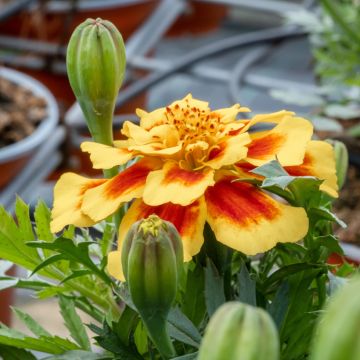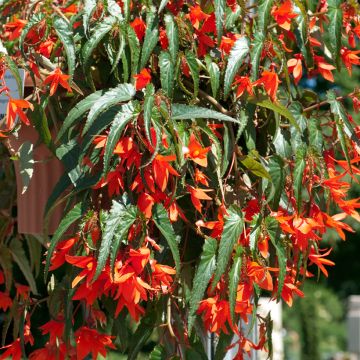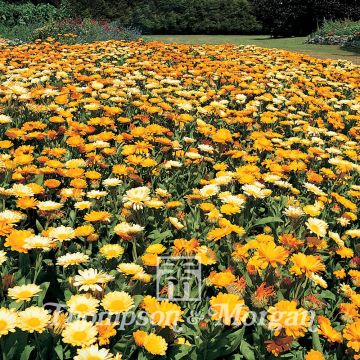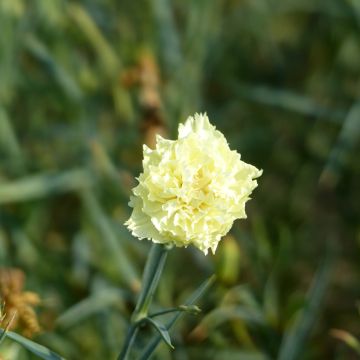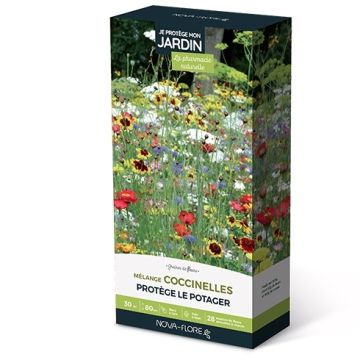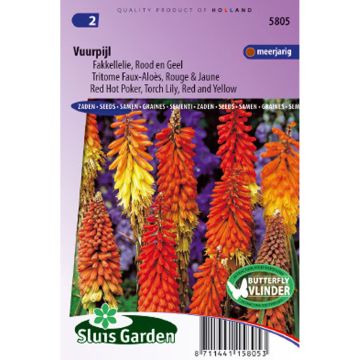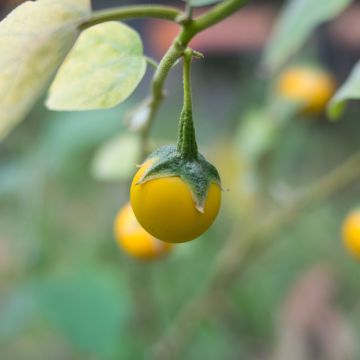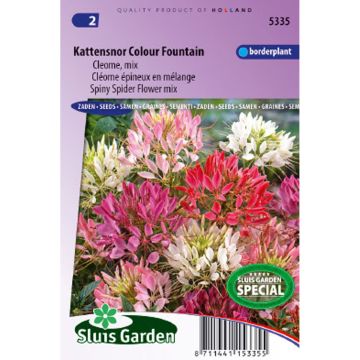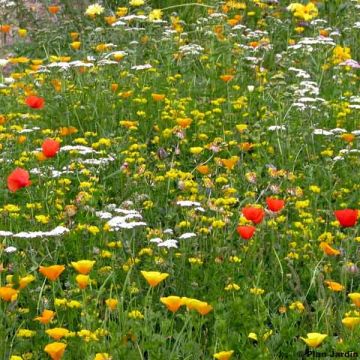

Schizanthus Dwarf Bouquet Mixed Seeds - Poor Mans Orchid Mix
Schizanthus Dwarf Bouquet Mixed Seeds - Poor Mans Orchid Mix
Schizanthus hybridus Dwarf Bouquet Mixed
Butterfly Flower
This item cannot be shipped to the selected country
Dispatch by letter from €3.90
More information
Schedule delivery date,
and select date in basket
This plant carries a 6 months recovery warranty
More information
We guarantee the quality of our plants for a full growing cycle, and will replace at our expense any plant that fails to recover under normal climatic and planting conditions.
Seed-only orders are dispatched by sealed envelope. The delivery charge for seed-only orders is €3.90.
Does this plant fit my garden?
Set up your Plantfit profile →
Description
This mix of Schizanthus Dwarf Bouquet Mixed also called Poor Man's Orchid, is anything but pitiful looking. The compact plants bears magical blooms in the shape of beautiful orchids that come in a harmonious blend of purple, pink, orange, pink and salmon shades. Flowering throughout the whole season, these plants, often grown as annuals, are excellent in pots, planters, hanging baskets and borders. They appreciate sunny positions and well-drained, fertile soils.
Schizanthus hybrids are the result of cross-breeding between species originating from the mountains of Chile and Argentina. They are herbaceous perennials or biennials which are often grown as annuals and belong to the family Solanaceae, along with petunias, potatoes or tomatoes. The plants in the 'Dwarf Bouquet Mixed' selection are distinguished by their compact habit and prolific blooming. They form mounds reaching 30 to 38 cm in height and 30 cm in diameter, consisting of stems with leaves that measure 8 to 12 cm long and that are dark green, very dissected, a bit like the leaf of a fern. The flowers are produced in abundance from June to September-October, depending on the date of sowing. Each corolla measures 5 cm in diameter, is reminiscent of an orchid and comes in shades ranging from red to pink, orange and salmon, revealing a gold-spotted throat.
While they are perfect in flower pots and hanging baskets, Schizanthus Dwarf Bouquet Mixed can also be used to create fantastic borders. Although they bloom briefly, their flowers are truly dazzling. It's a good idea to stagger the seedlings so that you can enjoy the blooms until the first frosts. These plants, of mountain origin, do not like heat and associate well with alpine plants such as rock jasmine, Dicentra formosa, Lewisia cotyledon. They can also be used as short-lived houseplants.
Report an error about the product description
Flowering
Foliage
Plant habit
Botanical data
Schizanthus
hybridus
Dwarf Bouquet Mixed
Solanaceae
Butterfly Flower
Cultivar or hybrid
Other Thompson and Morgan seeds
Planting and care
Sow in March-April or August-September, to ensure an earlier flowering that will start in late spring.
Sow the Schizanthus seeds in trays, pots, etc. in a special seed starting mix, which you will place in a propagator or in a warm place to maintain an optimal temperature of 13 to 15 °C. Place the seeds on the surface of the compost. After sowing, do not exclude light as this helps germination. Germination usually takes 14 to 30 days.
Prick out young plants that are large enough to be handled. Harden them off and plant out when there is no longer any risk of frost. Keep a 30 cm spacing between each plant.
Schizanthus are a subtropical mountain species that enjoys a mild, frost-free climate. In colder climates, it is necessary to grow them in temperate glasshouses. These plants thrive in the sun or partial shade in fertile, moist and well-drained soil, in warm climates. You can pinch the young plants when they reach a height of 10 cm to force them to branch.
Sowing period
Intended location
This item has not been reviewed yet - be the first to leave a review about it.
Flower seeds
Haven't found what you were looking for?
Hardiness is the lowest winter temperature a plant can endure without suffering serious damage or even dying. However, hardiness is affected by location (a sheltered area, such as a patio), protection (winter cover) and soil type (hardiness is improved by well-drained soil).

Photo Sharing Terms & Conditions
In order to encourage gardeners to interact and share their experiences, Promesse de fleurs offers various media enabling content to be uploaded onto its Site - in particular via the ‘Photo sharing’ module.
The User agrees to refrain from:
- Posting any content that is illegal, prejudicial, insulting, racist, inciteful to hatred, revisionist, contrary to public decency, that infringes on privacy or on the privacy rights of third parties, in particular the publicity rights of persons and goods, intellectual property rights, or the right to privacy.
- Submitting content on behalf of a third party;
- Impersonate the identity of a third party and/or publish any personal information about a third party;
In general, the User undertakes to refrain from any unethical behaviour.
All Content (in particular text, comments, files, images, photos, videos, creative works, etc.), which may be subject to property or intellectual property rights, image or other private rights, shall remain the property of the User, subject to the limited rights granted by the terms of the licence granted by Promesse de fleurs as stated below. Users are at liberty to publish or not to publish such Content on the Site, notably via the ‘Photo Sharing’ facility, and accept that this Content shall be made public and freely accessible, notably on the Internet.
Users further acknowledge, undertake to have ,and guarantee that they hold all necessary rights and permissions to publish such material on the Site, in particular with regard to the legislation in force pertaining to any privacy, property, intellectual property, image, or contractual rights, or rights of any other nature. By publishing such Content on the Site, Users acknowledge accepting full liability as publishers of the Content within the meaning of the law, and grant Promesse de fleurs, free of charge, an inclusive, worldwide licence for the said Content for the entire duration of its publication, including all reproduction, representation, up/downloading, displaying, performing, transmission, and storage rights.
Users also grant permission for their name to be linked to the Content and accept that this link may not always be made available.
By engaging in posting material, Users consent to their Content becoming automatically accessible on the Internet, in particular on other sites and/or blogs and/or web pages of the Promesse de fleurs site, including in particular social pages and the Promesse de fleurs catalogue.
Users may secure the removal of entrusted content free of charge by issuing a simple request via our contact form.
The flowering period indicated on our website applies to countries and regions located in USDA zone 8 (France, the United Kingdom, Ireland, the Netherlands, etc.)
It will vary according to where you live:
- In zones 9 to 10 (Italy, Spain, Greece, etc.), flowering will occur about 2 to 4 weeks earlier.
- In zones 6 to 7 (Germany, Poland, Slovenia, and lower mountainous regions), flowering will be delayed by 2 to 3 weeks.
- In zone 5 (Central Europe, Scandinavia), blooming will be delayed by 3 to 5 weeks.
In temperate climates, pruning of spring-flowering shrubs (forsythia, spireas, etc.) should be done just after flowering.
Pruning of summer-flowering shrubs (Indian Lilac, Perovskia, etc.) can be done in winter or spring.
In cold regions as well as with frost-sensitive plants, avoid pruning too early when severe frosts may still occur.
The planting period indicated on our website applies to countries and regions located in USDA zone 8 (France, United Kingdom, Ireland, Netherlands).
It will vary according to where you live:
- In Mediterranean zones (Marseille, Madrid, Milan, etc.), autumn and winter are the best planting periods.
- In continental zones (Strasbourg, Munich, Vienna, etc.), delay planting by 2 to 3 weeks in spring and bring it forward by 2 to 4 weeks in autumn.
- In mountainous regions (the Alps, Pyrenees, Carpathians, etc.), it is best to plant in late spring (May-June) or late summer (August-September).
The harvesting period indicated on our website applies to countries and regions in USDA zone 8 (France, England, Ireland, the Netherlands).
In colder areas (Scandinavia, Poland, Austria...) fruit and vegetable harvests are likely to be delayed by 3-4 weeks.
In warmer areas (Italy, Spain, Greece, etc.), harvesting will probably take place earlier, depending on weather conditions.
The sowing periods indicated on our website apply to countries and regions within USDA Zone 8 (France, UK, Ireland, Netherlands).
In colder areas (Scandinavia, Poland, Austria...), delay any outdoor sowing by 3-4 weeks, or sow under glass.
In warmer climes (Italy, Spain, Greece, etc.), bring outdoor sowing forward by a few weeks.


































